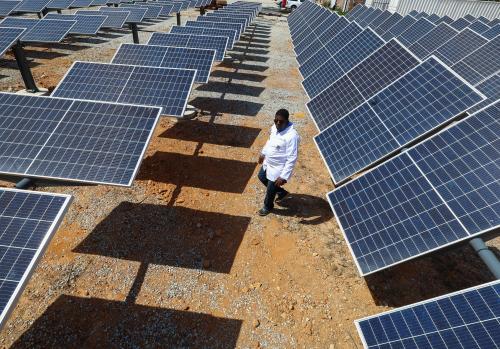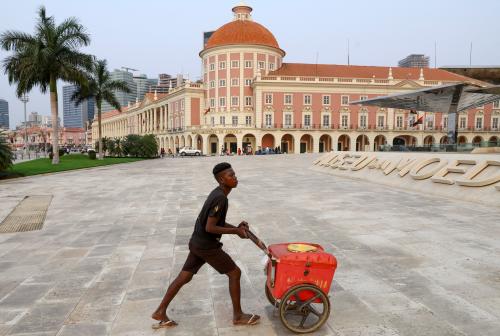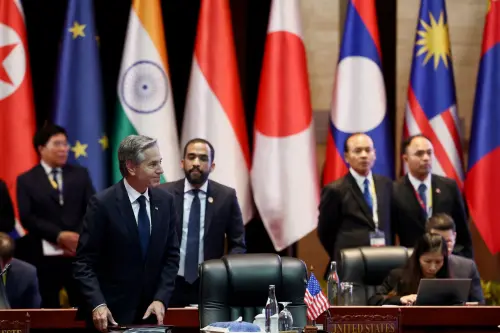The years since the “New Russia’s” first democratic presidential election in 1991 have been five harsh ones for the nation’s defense-industrial complex. According to data from its government, Russia’s arms manufacturers in 1995 produced barely one-ninth the military output they had in 1990. Civilian production by defense plants, relatively stable through 1993, fell in 1994 and 1995 as fast or faster than military output.
By the spring of 1995, Russian authorities had declared more than 200 defense enterprises or institutes financially insolvent. Many more were on the verge of insolvency.
But what will happen next is unclear. The Russian government has yet to take the step of declaring the enterprises formally bankrupt. Lacking paying customers and incapable of paying their debts, these enterprises, including some of Russia’s largest manufacturing plants, nevertheless continue to exist as legal entities and, more important, as social institutions. Though the allocation of society’s resources into military production has declined radically, the ultimate fate of Russia’s defense enterprises still hangs in the balance—and with them, the fate of the people and the communities that depend on them.
All this adds up to a series of questions and possible challenges, both for the Russian government and for the West.
When Costs Matter
The biggest change for the defense industry in the past five years has been market reform itself. Under the non-market, “command-administrative” economic system of the Soviet Union, defense enterprises enjoyed priority access to skilled and disciplined workers, up-to-date technology, and reliable supplies of other high-quality inputs. These inputs were allocated administratively, without regard to their economic costs—that is, their potential value to other sectors of the economy. Once market reforms began to reveal the real cost of these inputs, the advantages previously enjoyed by defense enterprises could not survive. When administrative allocation of resources was abandoned, the defense enterprise lost its right to prized raw materials. When Soviet citizens were given the freedom to choose their occupations and places of work, the defense enterprise was deprived of its skilled labor. The further along the path toward market reform Russia has moved, the more these trends have intensified. By now, the verdict of the market is clear: Russia’s defense enterprises have shown themselves to be singularly ill-suited for transformation into capitalist firms. For many, no realistic degree of “adjustment” will accomplish the task.
The Criterion of the World Market
There are exceptions to this bleak picture. Two groups of Russian defense enterprises, though not yet prosperous, at least have the potential to survive. The key in both cases has been acceptance in the world market. The first group makes arms for export. Early in the post-Soviet era, expectations regarding Russian arms exports were exaggerated, and arms sales were disappointing. Today, grounds for cautious optimism exist. Nations such as China, South Korea, Malaysia, and India want serviceable weapons at a low price, and all have recently concluded arms deals with Russia. In 1994 Russian arms sales overseas totaled $1.7 billion; sales for 1995 may have been as high as $2.5 billion. Weapons are already Russia’s largest manufactured export.
Several cautionary notes, however, are necessary. First, many of the Russian arms sold in recent years have come from inventory and reflect only previous production. It has not yet been proven that Russian arms produced under today’s conditions can be as good, and as competitively priced, as they once were. Second, even in the best possible future scenario (with foreign arms sales totaling $4 billion a year), the arms export business would employ roughly only one-fifth of those once needed to produce the arms the Soviet Union shipped abroad.
A second group of enterprises is gaining world market acceptance by participating in joint ventures with established Western firms. Some of these cooperative deals, especially in electronics and aerospace, have garnered much publicity. But despite the media attention, the real volume of foreign investment in the defense sector has been quite modest—probably not more than $10-20 million in each of the past few years. While that figure should increase as foreign investment in Russia grows, foreign ventures are not likely to encompass many more enterprises than they already do.
Domestic Strategies
What of the remaining defense enterprises? If they cannot compete internationally, can they prosper in the Russian market?
The defense enterprises’ record in civilian production is poor. The consumer goods that Russian defense plants make— refrigerators, washing machines, and the like—do have a market, but much of it has already been lost to foreign imports. Even an apparent advantage such as local presence, which should have offered Russian defense plants thorough knowledge of their home market and a better position to provide service and maintenance, has not helped. Not surprisingly, defense industry representatives have little faith in the future of converting to civilian production.
What of weapons procurement for Russia’s armed forces? Although Russia may never spend more than a fraction of what the Soviet Union did on its defense establishment, future spending will go up. Under almost any realistic projection of its future, Russia will need more arms than it now produces.
Political, social, even geographic considerations will affect the choice of enterprises supported through defense orders. Pressure to spread procurement rubles over too many enterprises will be constant. But the countervailing pressure from the world market will also be strong. Russia will ultimately have to shape its domestic procurement policy in light of the success of its exporters. In the long run, it will be hard to defend a policy with one set of defense enterprises successfully selling weapons on the world market, another producing arms only for Russia.
More Radical Changes?
The foregoing discussion, of course, assumes that the Russian defense enterprises carry on in their traditional structure—as “company towns” that provide not only jobs, but also housing, health care, schools, and recreation to their workers and their families. Would their future look brighter if they underwent substantially more radical changes?
The most important change would be to reduce costs. The labor force would have to be cut drastically, and social services would have to be virtually eliminated. Current defense enterprise managers, however, would find it unthinkable to tear down the very structures they spent their lives building up. Only new management brought in from the outside could attempt it. But such a change is extremely unlikely, given continued state involvement in the industry.
At present, slightly more than one-third of all former defense enterprises in Russia have been fully privatized. Another one-third remain fully state owned. The state has partial ownership of the final third. The status of most of that latter group is particularly unclear and likely to remain so. In some cases, the state owns a controlling package of shares. In others, it retains a “golden share” that conveys the right to veto certain management decisions. But the state needn’t own an enterprise to influence its management: other levers of control are available, even in fully privatized companies. For example, the state must approve the appointment of the director of any enterprise, public or private, that produces weapons. And indications are that critical decisions on strategic issues, such as ownership or partnerships with outside investors, will also require state approval.
The takeover battles in the Russian economy have just begun. Thanks to the macroeconomic stabilization that Russia achieved in 1995, manufacturing has begun to attract financial capital. Some defense enterprises, priced low but with valuable assets, including prime real estate in large urban centers, are targets. They could be made profitable. Whether Russia has the social and political will to make that possible is another matter. For the defense enterprises the issue is more than mere survival—it is survival at what cost and at whose expense.
The ultimate arbiters in the fate of many defense enterprises may not be in Moscow but in the defense regions. City and regional governments there will almost surely oppose cuts both in the labor force and in social services. The former cuts burden the city with fired workers who are hard to employ; the latter leave the city government responsible for providing vital social services.
However their future unfolds, the defense enterprises will continue to be costly to Russia. They are a direct drain on the national budget, of course, though perhaps not as great a drain as some suggest, for developing a separate social safety net in their place would entail major expenses. But an even greater cost is the failure to put to productive use the resources of the enterprises. The plants will not divest productive infrastructure, real estate, or other assets as fast as they downsize their labor forces. One tragedy of demilitarization so far has been the large number of workers from the defense sector who are ready and willing to engage in new and economically viable work but who lack the tools to realize their potential. If more of the physical assets are not released from the control of the defense enterprises, there is little hope of success in building up a vibrant alternative local economy.
Human Capital
Ultimately, the yardstick of demilitarization policy is the fate of those who made up the defense complex. For all Russia’s natural wealth, the nation’s talented workforce may be its biggest asset and the key to its economic future.
Russians and foreigners alike often refer to Russia’s vast human capital. And it is true that the country has a huge number of educated citizens with professional experience in an industrial economy. But viewed by the demands of a market economy, Russia’s human capital is more potential than real. For decades under the old Soviet system, Russians had been encouraged to make what today appear as wrong choices about their education, their occupations, and their places of work.
Russia’s challenge today is to realize and give value to its potential human capital by enabling people to find better matches between their skills and preferences and their professions and to find rewards in the market. This poses a dilemma for policy toward the defense-industrial complex. Many of the entrepreneurial individuals who today are most active in helping establish the market come from the ranks of those with scientific and technical skills. In the eyes of some, especially those in positions of leadership in the defense industry, this trend represents a serious “internal brain drain” that must be stopped. But to the extent that policymakers continue their efforts to slow down the exodus of talent from science and industry, they will not be preserving the nation’s human capital but impeding its realization. If one lesson is to be learned from demilitarization, it is that continued constraints on the market are counterproductive. Privileges and exemptions for the defense industry still seriously restrict the free play of market forces so vital to normalization of the Russian economy. The goal of normality is not a state that anyone in Russia now knows. Only the freedom of Russia’s people to choose what is most important for them—what they want to do or buy, what futures they want for themselves and their children—is what will lead to normality.
Restricting free choice can only encourage people again to make wrong choices and thereby reduce the value of the economic activity in which they are engaged. In the past, the militarization of Russia’s economy did this in the extreme, wasting not only the nation’s physical resources but also the life work of generations of its citizens. Russians deserve to know that what they choose to do will have meaning and value today and tomorrow.
What Role for the West?
Russian policymakers have important decisions to make on economic issues relating to the legacy of militarization. Most boil down to establishing priorities and striking a balance between conflicting social goals, and they must be left to the Russians themselves. Any American or foreign contribution could be marginal at best—and in an area that represents a political mine field no less explosive than some of our own domestic debates on U.S. economic priorities. The sensitivity and pride that often encumber the U.S.-Russian relationship are especially acute regarding the defense industry. For Americans, this means that for most of the drama of Russian demilitarization, we are passive onlookers—a particularly frustrating role, of course, because the stakes are so high but the ability to influence is quite small.
One point about how the United State relates to Russian demilitarization is often neglected. In looking at the connection between economic reform and politics, Washington has so far been concerned mainly with the possible consequences of the failure of Russia economic reform. Less attention has been paid to the way in which success in economic reform will surely complicate relations between the United States and Russia politically, especially regarding security issues.
From the standpoint of Western security policy, Russia’s current economic weakness has been an unexpected benefit. Since the demise of the Soviet Union, Russia has been restrained (indeed, passive) on the international scene. But Russia is growing economically stronger, partly because of economic reform and partly because the nation is recovering its balance after a period of sudden and wrenching dislocation following the breakup of the Soviet Union. As Russia gains economic strength, it will be capable of more assertive postures in many areas. Barring a radical reversal of current trends, post-Soviet Russia will in the next few years have many options it has not yet had in its brief existence as a nation—options in international relations vis-a-vis the developed West, the third world, and, most immediately, its neighbors from the former Soviet Union.
An economically stronger Russia will also be able to spend more on its defense. Undoubtedly, this alone will be enough to cause some in the West to warn of resurgent militarism in Russia. But to react reflexively in this way would be a mistake. Just as the goal of demilitarizing Russia does not mean disarming it or taking away its ability to provide for its legitimate security needs, so too we must distinguish between increased arms spending and remilitarization. In years to come, various political forces in Russia may differ in the degree of emphasis to be placed on national security, specifically on levels of spending on arms. To the extent that Russia remains a democratic society, those debates will be resolved as its citizens choose among various societal priorities, just as we do. As long as RussiaÕs economy and politics remain free and open, there is no possibility of a return to the hypermilitarized society of the past, regardless of any rhetoric about restoring Russia’s superpower status. A market economy will make clear the true cost of a return to militarization; freedom of political expression will ensure that the cost will be made known to the citizenry.
Both Russians and Westerners alike must take seriously any attempts, by any leadership, to abolish democratic freedoms and reintroduce the economic policies of coercion, secrecy, heavy regulation, and administered prices. Those policies helped conceal the true cost of the militarization of the Russian economy in the first place. Reinstituted today, they would make it much more likely that the mistakes of the past would be repeated.



Commentary
No Turning Back: Market Reform and Defense Industry in Russia: Who’s adjusting to whom?
June 1, 1996